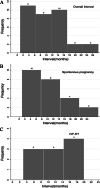Reproductive and postsurgical outcomes of infertile women with deep infiltrating endometriosis
- PMID: 35313876
- PMCID: PMC8939234
- DOI: 10.1186/s12905-022-01666-5
Reproductive and postsurgical outcomes of infertile women with deep infiltrating endometriosis
Abstract
Background: This study aimed to summarize and analyze clinical characteristics and reproductive outcomes in postoperative deep infiltrating endometriosis (DIE).
Methods: This retrospective cohort study included 55 reproductive-aged patients who were diagnosed with DIE, wished to conceive and underwent resection surgery at the Obstetrics and Gynecology Hospital, Fudan University, from January 2009-June 2017. Those with any plausible infertility factor or abnormalities in the partner's semen analysis were excluded. Patient characteristics, preoperative symptoms, infertility history, intraoperative findings and reproductive outcomes were followed up and recorded. Risk factors for reproductive outcomes were identified for women who became pregnant versus those who did not by univariate logistic regression. Additionally, pre- and postoperative endometriosis health profile questionnaire-30 (EHP-30), Knowles-Eccersley-Scott Symptom questionnaire (KESS), Cox Menstrual Symptom Scale (CMSS) and Female Sexual Function Index (FSFI) scores were used to evaluate the effect of DIE surgery on quality of life.
Results: The average age was 30.22 ± 3.62 years, with no difference between the pregnancy and nonpregnancy groups. The average follow-up time was 26.57 ± 14.51 months. There were 34 pregnancies (61.82%): 24 (70.59%) conceived spontaneously and 10 (29.41%) by in vitro fertilization (IVF). Twenty-eight patients (82.35%) had term deliveries. The interval between operation and pregnancy was 10.33 ± 5.6 (1-26) months. Univariate analysis showed that a lower endometriosis fertility index (EFI) score (EFI < 8) was a risk factor for infertility (OR: 3.17 (1.15-10.14), p = .044). For patients with incomplete surgery, postoperative gonadotropin-releasing hormone agonist (GnRHa) administration improved the pregnancy rate (p < 0.05). Regarding quality of life, there was significant improvement (p < 0.05) in the postoperative EHP-30, KESS and CMSS scores compared with preoperative scores in both groups. Although there was no obvious difference in FSFI scores, significant improvement in dyspareunia was observed (p < 0.05).
Conclusions: Overall, the postoperative pregnancy rate of DIE patients was 61.82%. Surgical management of DIE for patients with complaints of pain and with pregnancy intentions was feasible and effective. Long-term expectant treatment should not be advised for patients with lower EFI scores (EFI < 8), and postoperative IVF-ET may be a good choice. More cases should be enrolled for further study, and randomized studies are required.
Keywords: Deep infiltrating endometriosis; Life and sex quality; Reproductive outcome; Surgery.
© 2022. The Author(s).
Conflict of interest statement
The authors declare no potential conflicts of interest with the research, authorship, and/or publication of this article.
Figures


References
-
- Johnson NP, Hummelshoj L, World Endometriosis Society Montpellier C. Consensus on current management of endometriosis. Hum Reprod. 2013;28(6):1552–68. - PubMed
Publication types
MeSH terms
LinkOut - more resources
Full Text Sources
Medical

